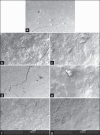Zinc cross-linked hydroxamated alginates for pulsed drug release
- PMID: 24350039
- PMCID: PMC3853759
- DOI: 10.4103/2230-973X.121292
Zinc cross-linked hydroxamated alginates for pulsed drug release
Abstract
Introduction: Alginates can be tailored chemically to improve solubility, physicochemical, and biological properties and its complexation with metal ion is useful for controlling the drug release.
Materials and methods: Synthesized N,O-dimethyl, N-methyl, or N-Benzyl hydroxylamine derivatives of sodium alginate were subsequently complexed with zinc to form beads. Hydroxamation of sodium alginate was confirmed by Fourier transform infra-red spectroscopy (FTIR) and differential scanning calorimetry (DSC).
Results: The synthesized polymeric material exhibited reduced aqueous, HCl and NaOH solubility. The hydroxamated derivatives demonstrated pulsed release where change in pH of the dissolution medium stimulated the atenolol release.
Conclusion: Atenolol loaded Zn cross-linked polymeric beads demonstrated the sustained the plasma drug levels with increased half-life. Although the synthesized derivatives greatly altered the aqueous solubility of sodium alginate, no significant differences in in vitro and in vivo atenolol release behavior amongst the N,O-dimethyl, N-methyl, or N-Benzyl hydroxylamine derivatives of sodium alginate were observed.
Keywords: Atenolol; hydroxylamine derivatives; metal-polymer cross-linked beads; pulsatile release; sodium alginate.
Conflict of interest statement
Figures






Similar articles
-
Design of controlled-release solid dosage forms of alginate and chitosan using microwave.J Control Release. 2002 Dec 5;84(3):99-114. doi: 10.1016/s0168-3659(02)00237-7. J Control Release. 2002. PMID: 12468214
-
Development of novel gastroretentive drug delivery system of gliclazide: hollow beads.Drug Dev Ind Pharm. 2014 Mar;40(3):398-408. doi: 10.3109/03639045.2013.763817. Epub 2013 Feb 18. Drug Dev Ind Pharm. 2014. PMID: 23418961
-
Sodium lauryl sulfate impedes drug release from zinc-crosslinked alginate beads: switching from enteric coating release into biphasic profiles.Int J Pharm. 2008 Feb 28;350(1-2):291-300. doi: 10.1016/j.ijpharm.2007.09.010. Epub 2007 Sep 14. Int J Pharm. 2008. PMID: 17980979
-
Release characteristics of diclofenac sodium from poly(vinyl alcohol)/sodium alginate and poly(vinyl alcohol)-grafted-poly(acrylamide)/sodium alginate blend beads.Eur J Pharm Biopharm. 2007 Feb;65(2):204-14. doi: 10.1016/j.ejpb.2006.08.004. Epub 2006 Aug 18. Eur J Pharm Biopharm. 2007. PMID: 16996255
-
Entrapment efficiency and release characteristics of polyethyleneimine-treated or -untreated calcium alginate beads loaded with propranolol-resin complex.Int J Pharm. 2005 Sep 30;302(1-2):84-94. doi: 10.1016/j.ijpharm.2005.06.020. Int J Pharm. 2005. PMID: 16102927
Cited by
-
Gallic Acid-Loaded Sodium Alginate-Based (Polyvinyl Alcohol-Co-Acrylic Acid) Hydrogel Membranes for Cutaneous Wound Healing: Synthesis and Characterization.Molecules. 2022 Dec 1;27(23):8397. doi: 10.3390/molecules27238397. Molecules. 2022. PMID: 36500491 Free PMC article.
-
Encapsulation with Natural Polymers to Improve the Properties of Biostimulants in Agriculture.Plants (Basel). 2022 Dec 22;12(1):55. doi: 10.3390/plants12010055. Plants (Basel). 2022. PMID: 36616183 Free PMC article. Review.
-
A comprehensive physicochemical, thermal, and spectroscopic characterization of zinc (II) chloride using X-ray diffraction, particle size distribution, differential scanning calorimetry, thermogravimetric analysis/differential thermogravimetric analysis, ultraviolet-visible, and Fourier transform-infrared spectroscopy.Int J Pharm Investig. 2017 Jan-Mar;7(1):33-40. doi: 10.4103/jphi.JPHI_2_17. Int J Pharm Investig. 2017. PMID: 28405577 Free PMC article.
-
Zinc Acetate as a Cross-Linking Agent in the Development of Enteric Microcapsules for Posaconazole.Pharmaceutics. 2025 Feb 22;17(3):291. doi: 10.3390/pharmaceutics17030291. Pharmaceutics. 2025. PMID: 40142955 Free PMC article.
-
Current Status of Alginate in Drug Delivery.Adv Pharmacol Pharm Sci. 2020 Aug 6;2020:8886095. doi: 10.1155/2020/8886095. eCollection 2020. Adv Pharmacol Pharm Sci. 2020. PMID: 32832902 Free PMC article. Review.
References
-
- Ritschel WA, Forusz H. Chronopharmacology: A review of drugs studies. Methods Find Exp Clin Pharmacol. 1994;16:57–75. - PubMed
-
- Lemmer B. Chronopharmacokinetics: Implications for drug treatment. J Pharm Pharmacol. 1999;51:887–90. - PubMed
-
- Bussemer T, Otto I, Bodmeier R. Pulsatile drug-delivery systems. Crit Rev Ther Drug. 2001;18:433–58. - PubMed
-
- Liu L, Fishman ML, Kost J, Hicks KB. Pectin-based systems for colon specific drug delivery via oral route. Biomaterials. 2003;24:3333–43. - PubMed
-
- Bourgeois S, Gernet M, Pradeau D, Andremont A, Fattal E. Evaluation of critical formulation parameters influencing the bioactivity of [beta]-lactamases entrapped in pectin beads. Int J Pharm. 2006;324:2–9. - PubMed
LinkOut - more resources
Full Text Sources
Other Literature Sources
